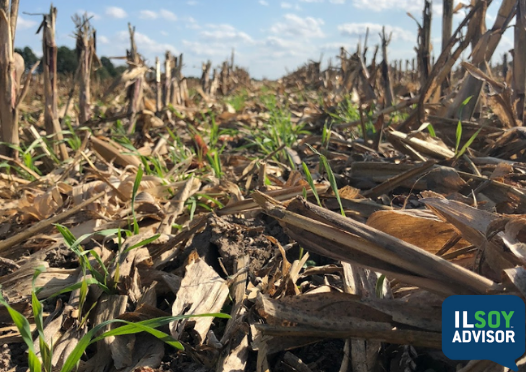ILSOYADVISOR POST
Cover Crops: Why Not Wheat?
I have attended several meetings the last few weeks where the topic of cover crops has been discussed at length by different speakers approaching the subject from different angles. The general focus of cover crop use at these meetings is to accomplish two different tasks: 1) Sequester nutrients either from highly erodible land or sensitive areas in watersheds and 2) help reduce erosion on highly erodible lands (HEL). Both are becoming, if not already are, a desirable result as we approach nutrient management, Nutrient Loss Reduction Strategy (NLRS) and reducing loads in impaired watersheds.
In the meetings I attended there seemed to be little agreement on cover crop Best Management Practices (BMPs) from speaker to speaker and meeting to meeting. Some research was shown, often side-by-sides and plots, that had contradicting and often confusing results. In one presentation a cover crop was reported to have sequestered over 90 lbs. of nitrogen (N), yet when corn was planted into this terminated cover crop it took more N to produce the same yield compared to where no cover crop was planted.
So where did that captured N go? Another talk indicated that one could “prescribe” cover crop blends based on “soil health” and soil test data. Yet there was no evidence presented that this made any difference in NLRS or row crop yields. Even the BMPs for planting or termination of cover crops were as diverse as the speakers and meetings.
Confused yet? Well, I sure was by the time the last meeting was over. But with all that, there were two things that were common in all meetings.
The first was that buffer strips/filter strips work. Planting a cover crop buffer strip or filter strip along waterways and ditches cut down on nutrient runoff. On our farms the quickest way to help with the NLRS is to plant buffer/filter strips.
The second was planting wheat. Winter wheat is an excellent cover crop. Not only does it “sequester” nutrients, it cuts down on erosion on HEL ground. Plus, it has an added benefit—termination of the crop is at harvest. Meaning it was the only cover crop to show a return on investment (ROI).
Now granted, the last few years’ wheat quality at harvest has been a challenge, wheat prices have been low and achieving a positive ROI on a wheat crop has been a challenge. However, wheat is the only cover crop that has a chance to cover costs of production with the opportunity of getting a ROI. And with double-cropping soybeans, we get two crops to sell plus the benefits of the cover crop.
Wheat does take management and a successful wheat/double-crop soybean rotation takes more management. However, if we have farms where we need to use cover crops to help with erosion and nutrient sequestration, then why not plant a harvestable cover crop with income potential? In Southern Illinois wheat followed by double-crop soybeans are more profitable in many years than an “average” corn crop. Plus, wheat is a cover crop we already are set up to plant and know how to manage.
So, in all the talk about cover crops don’t ignore the one that we have already used for years—wheat.
Kelly is serving as the Illinois Soybean Association Double-Crop Specialist. He was raised on the family farm in Benton, Illinois and graduated from Southern Illinois University (SIU)-Carbondale with a BS in Agriculture Education and Mechanization, and a Master’s of Science (MS) in Plant and Soil Science. Kelly has spent 25 years as a soil fertility agronomist and precision agriculture consultant in southern Illinois while also spending 4 years as a Farm/Agronomy Manager and GIS Coordinator for a large farm in southeastern Illinois. He is a Certified Professional Agronomist and a Certified Crop Advisor.





Comments
Add new comment